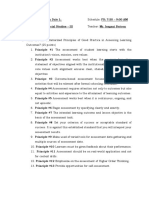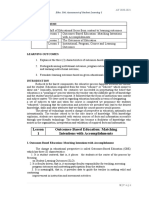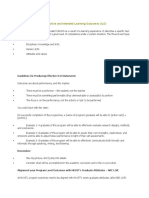0 ratings0% found this document useful (0 votes)
40 viewsCañete, Jeramie - Chapter 4
Cañete, Jeramie - Chapter 4
Uploaded by
Jeramie CañeteThe document outlines an assignment to assess student learning outcomes which includes summarizing principles of good practice in assessment, providing examples of supporting student activities aligned with learning outcomes, explaining the 11 phases of the outcome assessment cycle with examples, and fully explaining constructive alignment with an example. The assignment requires analyzing and applying concepts related to designing and implementing effective student assessment.
Copyright:
© All Rights Reserved
Available Formats
Download as PDF, TXT or read online from Scribd
Cañete, Jeramie - Chapter 4
Cañete, Jeramie - Chapter 4
Uploaded by
Jeramie Cañete0 ratings0% found this document useful (0 votes)
40 views5 pagesThe document outlines an assignment to assess student learning outcomes which includes summarizing principles of good practice in assessment, providing examples of supporting student activities aligned with learning outcomes, explaining the 11 phases of the outcome assessment cycle with examples, and fully explaining constructive alignment with an example. The assignment requires analyzing and applying concepts related to designing and implementing effective student assessment.
Original Title
CAÑETE, JERAMIE_CHAPTER 4
Copyright
© © All Rights Reserved
Available Formats
PDF, TXT or read online from Scribd
Share this document
Did you find this document useful?
Is this content inappropriate?
The document outlines an assignment to assess student learning outcomes which includes summarizing principles of good practice in assessment, providing examples of supporting student activities aligned with learning outcomes, explaining the 11 phases of the outcome assessment cycle with examples, and fully explaining constructive alignment with an example. The assignment requires analyzing and applying concepts related to designing and implementing effective student assessment.
Copyright:
© All Rights Reserved
Available Formats
Download as PDF, TXT or read online from Scribd
Download as pdf or txt
0 ratings0% found this document useful (0 votes)
40 views5 pagesCañete, Jeramie - Chapter 4
Cañete, Jeramie - Chapter 4
Uploaded by
Jeramie CañeteThe document outlines an assignment to assess student learning outcomes which includes summarizing principles of good practice in assessment, providing examples of supporting student activities aligned with learning outcomes, explaining the 11 phases of the outcome assessment cycle with examples, and fully explaining constructive alignment with an example. The assignment requires analyzing and applying concepts related to designing and implementing effective student assessment.
Copyright:
© All Rights Reserved
Available Formats
Download as PDF, TXT or read online from Scribd
Download as pdf or txt
You are on page 1of 5
Chapter 4
ASSESSING STUDENT LEARNING OUTCOMES
Assignment
Name: Jeramie V. Cañete Date: October 30, 2022
Course & Year: BEED 3 Schedule & Subj: PC 314- 19273 FS 12:00-1:30
1. What are the summarized Principles of Good Practice in Assessing Learning
Outcomes? (25 points)
- The Principles of Good Practice in Assessing Learning Outcomes are the
following;
a. The assessment of student learning starts with the institutions; vision,
mission, and core values.
b. Assessment works best when the program has clear statement of objectives
aligned with the institutional; vision, mission, and core values.
c. Outcome-based assessment focuses on the student activities that will be
relevant after formal schooling concludes.
d. Assessment requires attention not only to outcomes but also equal to
activities and experiences to the attainment of learning outcomes.
e. Assessment works best when it is continuous, ongoing and not episodic.
f. Begin assessment by specifying clearly and exactly.
g. The Intended Learning outcome/ Lesson objective is the basis of the
assessment task.
h. Set your criterion of success or acceptable standard of success.
i. Make use of varied tools for assessment data gathering and multiple sources
of assessment data.
j. Learners must be given feedback about their performance.
k. Assessment should be on real-world application and not out of context drills.
l. Emphasize on the assessment of Higher Order Thinking
m. Provide opportunities for self-assessment.
2. Give the Samples of Supporting Student Activities in line with the Student Learning
Outcomes. (15 points)
- The Samples of Supporting Student Activities in line with the Student Learning
Outcomes are the following;
1. Supporting Student Activities #1
1.1 solving problems through computing skills.
1.2 use online/computer-based tutorials and trainings.
2. Supporting Student Activities #2
2.1 making reflections based on the conditions at hand whether
individually or collaboratively.
2.2 analyzing researched information for more thorough understanding.
3. Supporting Student Activities #3
3.1 effectively communicating verbally with others one on one, in groups,
and/or in front of audiences.
3.2 Demonstrating a clear organization of one’s thoughts, using words
that reflect one’s intended meaning, and delivering the information in
a readable, clear, and concise manner in an essay.
3. Explain the 11 Phases of Outcome Assessment Cycle with Examples. (25 points)
3.1 Phase 1: Institutional Mission wherein the statements give advice on how to
attain the institution's educational goals to a variety of audiences, including
students, faculty, legislators, etc.
Example: The DepEd Mission that will protect and promote the right of every
Filipino to quality, equitable, culture-based, and complete basic education
where students learn in a child-friendly, gender sensitive, safe, and motivating
environment, where teachers facilitate learning and constantly nurture every
learner.
3.2 Phase 2: Programs Goals are comprehensive statements of the types of learning
that students will accomplish; they will give a general description of the learning
outcomes and concepts that a teacher may desire the students to acquire.
Example: The goal is to make the students develop positive cross-cultural
attitudes.
3.3 Phase 3: Subject Objectives are concise explanations of the knowledge that
students should have at the end of the year, course, unit, lesson, project, or
lesson time.
Example: By the end of the course, the students will be able to;
a. Understand physical fitness concepts and be able to make adaptations to
meet the fitness needs of individuals with disabilities.
b. Recognize and apply the developmental patterns and motor movements as
they relate to the performance of the basic skills in Physical Education,
Recreation, Music and Health
c. Appreciate the importance of a positive self-concept and emotional well-
being related to the diversity of special populations.
3.4 Phase 4: Desired Student Learning Outcomes are descriptions of essential and
important learning that students have attained and may trustable exhibit at the
conclusion of a course program.
Example: Demonstrate an ability to use appropriate assessment instruments to
determine student’s needs in the cognitive, psychomotor, and affective domains.
3.5 Phase 5: Diagnostic Assessment It is a method of assessment that looks at a
student's abilities and knowledge before a learning program is put into place.
Example: pre-and post-test, journal, multiple choice or short answer, peer and
self-evaluation, qualitative reading inventory, and diagnostic reading
assessment.
3.6 Phase 6: Deciding on Lesson Focus it is the primary lesson is the preliminary
step of a gradual release of responsibilities model. During this period, the
teacher should be modeling, sharing, and demonstrating to the children how
they should think.
3.7 Phase 7: Supporting Student Activities students will apply principles of logical
thinking and persuasive argument in writing that may form an opinion about the
topic that may involve researching and writing about a variety of perspectives
that can adapt style to identified audience and to employ clear argument in
writing.
3.8 Phase 8: Formative Assessment Outcome refers to a wide variety of methods
that teachers use to conduct in-process evaluations of student comprehension,
learning needs, and academic progress during a lesson, unit, or course.
Examples: Impromptu quizzes, silent classroom polls, lesson exit tickets to
summarize what pupils have learned and one-minutes papers on a specific
subject matter.
3.9 Phase 9: Review/Reteach it is when the teacher examines or assess (something)
formally with the possibility or intention of instituting change of necessary.
3.10 Phase 10: Mastery Learning is a method of instruction where the focus is on
the role of feedback in learning.
3.11 Phase 11: Summative Assessment of Outcomes it is the assessment of
participants where the focus is on the outcome of a program.
Example: End-of-term or midterm exams, cumulative work over an extended
period such as a final project or creative portfolio, end-of-unit or chapter tests
and standardized tests.
4. Explain fully the Constructive Alignment with the given Example(s). (25 points)
- Constructive Alignment is a teaching principle that combines alignment, a
concept in curriculum design that emphasizes the importance of defining and
achieving intended learning outcomes, with constructivism, the idea that learners
construct or create meaning out of learning activities and what they learn.
Furthermore, the technique of ensuring that the intended learning outcomes for
a course of study are efficient, evident, and meaningful as well as the
development of learning activities and assessment tasks in alignment with these
outcomes is known as "constructive alignment."
Example:
• Learning Outcome:
By the end of the course, the students will be able to plant a tree.
• Teaching-Learning Activities
Watch a demonstration of a landscaper planting a tree.
Visit a field with peers to practice planting a tree.
• Assessment Task/Method
Practical Exam where students demonstrate that they can plant a tree.
You might also like
- Module 5 Thematic Content, Assessment and PedagogyDocument23 pagesModule 5 Thematic Content, Assessment and PedagogyAllysa Marie SilbolNo ratings yet
- Alpuerto ASSESSING LEARNING OUTCOMES AssignmentDocument8 pagesAlpuerto ASSESSING LEARNING OUTCOMES Assignmentsweat sakuraNo ratings yet
- Assessing Student Learning Outcomes Al1Document5 pagesAssessing Student Learning Outcomes Al1Chekaina Rain Baldomar100% (1)
- Module 5-Student'sDocument13 pagesModule 5-Student'sFIL 1Rizza Luci VicenteNo ratings yet
- Assignment - Assessment of Student Learning OutcomesDocument6 pagesAssignment - Assessment of Student Learning OutcomesClaudine DimeNo ratings yet
- Islamic University of KenyaDocument9 pagesIslamic University of KenyaAleksander AlekeNo ratings yet
- Understanding by Design Framework PDFDocument3 pagesUnderstanding by Design Framework PDFMarissa EncaboNo ratings yet
- assessmentDocument39 pagesassessmentbagionjamesson12No ratings yet
- Educ6 Report Jessa Mae B. CantilaDocument36 pagesEduc6 Report Jessa Mae B. Cantilachan DesignsNo ratings yet
- Assessing Student Learning Outcomes 2Document37 pagesAssessing Student Learning Outcomes 2treciamaefabros40No ratings yet
- EDCI 321 AssignmentDocument5 pagesEDCI 321 Assignmentmutuad930No ratings yet
- Lesson planningGUIDEDocument11 pagesLesson planningGUIDEbenyfonNo ratings yet
- Introduction: Assessment and EvaluationDocument11 pagesIntroduction: Assessment and EvaluationPrarthana KakotyNo ratings yet
- Module 12 - Assessment of Student Learning SupplemetalDocument28 pagesModule 12 - Assessment of Student Learning SupplemetalRachelle malnawaNo ratings yet
- AL2 IM - Up To FinalsDocument85 pagesAL2 IM - Up To FinalsVanessa Poquita100% (1)
- Midterm Exam Part 2Document4 pagesMidterm Exam Part 2Wilmar EspinosaNo ratings yet
- Educ 61 Chapter 1 HandoutsDocument7 pagesEduc 61 Chapter 1 HandoutsJEZIEL BALANo ratings yet
- Assessment in Learning FinalDocument7 pagesAssessment in Learning FinalJEZIEL BALANo ratings yet
- Assessment in Learning 1 G2Document49 pagesAssessment in Learning 1 G2jezreeldavemontesNo ratings yet
- Assessment 1 Module 1-1Document8 pagesAssessment 1 Module 1-1Christine Sheena Batican-Bulala0% (1)
- Assess 2 Module 1 Lesson 1Document5 pagesAssess 2 Module 1 Lesson 1Jennifer Cortez TanNo ratings yet
- 8602 (Educational Assessment and Evaluation. 01)Document20 pages8602 (Educational Assessment and Evaluation. 01)SamraNo ratings yet
- Make A Written Assessment On All The Topics Discussed From Lesson 1 To 12. Title: Practice Tests Simple RecallDocument8 pagesMake A Written Assessment On All The Topics Discussed From Lesson 1 To 12. Title: Practice Tests Simple RecallColeen Reambonanza MaturanNo ratings yet
- Indicative Content: Lesson 1 Outcomes-Based Education: Matching Intentions With AccomplishmentsDocument8 pagesIndicative Content: Lesson 1 Outcomes-Based Education: Matching Intentions With AccomplishmentsJoshua Conlu MoisesNo ratings yet
- 8602 Solved Assign 1Document11 pages8602 Solved Assign 1Huma DawoodNo ratings yet
- The Outcomes Assessment Phases in The Instructional CycleDocument4 pagesThe Outcomes Assessment Phases in The Instructional Cyclemarvin cayabyab100% (2)
- Day 5 Eman LCT AssessmentDocument84 pagesDay 5 Eman LCT AssessmentMiyNo ratings yet
- Curriculum Development: Module 7: Fundamental of Curriculum DesigningDocument22 pagesCurriculum Development: Module 7: Fundamental of Curriculum DesigningMark Angelo De GraciaNo ratings yet
- Defining Curriculum Objective and Intended Learning OutcomesDocument9 pagesDefining Curriculum Objective and Intended Learning OutcomesKrizzle Jane PaguelNo ratings yet
- Teacher Professional Growth Plan 1 ps2 3Document6 pagesTeacher Professional Growth Plan 1 ps2 3api-606335653No ratings yet
- ASLDocument10 pagesASLLoreto TamayoNo ratings yet
- 8601.Document26 pages8601.Zujaja AkramNo ratings yet
- Educator AS Assessor . Name: PamellaDocument12 pagesEducator AS Assessor . Name: PamellapamellaNo ratings yet
- My ReportDocument20 pagesMy Reportconnie batucanNo ratings yet
- Elements of CurriculumDocument27 pagesElements of CurriculumAli imtiazNo ratings yet
- 8601-1Document27 pages8601-1ruksana bibiNo ratings yet
- Week 1 Tutorial DiscussionDocument4 pagesWeek 1 Tutorial DiscussionAnagha AnnNo ratings yet
- Pointers For AssessmentDocument9 pagesPointers For AssessmentErnestoNo ratings yet
- Educational Assesment and EvaluationDocument6 pagesEducational Assesment and EvaluationmrashidnawazfiverrNo ratings yet
- Unit 3 Phases and Processes of Curriculum DevelopmentDocument4 pagesUnit 3 Phases and Processes of Curriculum DevelopmentDara Rose FilosofoNo ratings yet
- OBE Principles and ProcessDocument8 pagesOBE Principles and Processgladys laguraNo ratings yet
- Policy Guidelines On Classroom Assessment For The K To 12 Basic Education ProgramDocument10 pagesPolicy Guidelines On Classroom Assessment For The K To 12 Basic Education ProgramMuriel Tan100% (2)
- 8602 Solved Assignment 1Document19 pages8602 Solved Assignment 1Danial KhadimNo ratings yet
- DepEd ClassroomDocument8 pagesDepEd ClassroomWilson Alcaide Lita Jr.No ratings yet
- Microteaching in Secondary Social Studies Lesson 1: PlanningDocument30 pagesMicroteaching in Secondary Social Studies Lesson 1: PlanningEhm MelsNo ratings yet
- Goals of Teaching 1Document22 pagesGoals of Teaching 1joannNo ratings yet
- Assessment Under The K To 12 For Private SchoolsDocument89 pagesAssessment Under The K To 12 For Private Schoolsrichard alicawayNo ratings yet
- ASSESSING STUDENT LEARNING OUTCOMES AssignmentDocument6 pagesASSESSING STUDENT LEARNING OUTCOMES AssignmentNoeh Loyd EspinosaNo ratings yet
- Writing A Lesson PlanDocument2 pagesWriting A Lesson PlanJade ElleneNo ratings yet
- Ed107 Module3Document7 pagesEd107 Module3Veronica FiedacanNo ratings yet
- Module1 LESSONDocument5 pagesModule1 LESSONdylyn jane gallegoNo ratings yet
- Chapter 2 Target SettingDocument24 pagesChapter 2 Target SettingAthea SalvadorNo ratings yet
- Designing POGIL ActivitiesDocument6 pagesDesigning POGIL ActivitiesCogut Macan DudutzNo ratings yet
- Written ReportDocument12 pagesWritten ReportAngel JoyNo ratings yet
- WK 12 Module Viii Educ 211Document6 pagesWK 12 Module Viii Educ 211bosiboribeatrice25No ratings yet
- ICE Prioritization Brainstorm PresentationDocument112 pagesICE Prioritization Brainstorm Presentationnika marl TindocNo ratings yet
- Process-Oriented, Performance Based AssessmentDocument9 pagesProcess-Oriented, Performance Based AssessmentallanNo ratings yet
- Prof. Ed. 9 MODULE 3Document8 pagesProf. Ed. 9 MODULE 3Sarah B. MaramagNo ratings yet
- How to Practice Before Exams: A Comprehensive Guide to Mastering Study Techniques, Time Management, and Stress Relief for Exam SuccessFrom EverandHow to Practice Before Exams: A Comprehensive Guide to Mastering Study Techniques, Time Management, and Stress Relief for Exam SuccessNo ratings yet
- The Structured Method of Pedagogy: Effective Teaching in the Era of the New Mission for Public Education in the United StatesFrom EverandThe Structured Method of Pedagogy: Effective Teaching in the Era of the New Mission for Public Education in the United StatesNo ratings yet
- Stem Practical Research 1 S.Y 2020 2021Document36 pagesStem Practical Research 1 S.Y 2020 2021Kristoffer PlonterasNo ratings yet
- Pengaruh Harga, Kualitas Produk, Dan Brand Love Terhadap Loyalitas Pelanggan Pada Minimarket IndomaretDocument25 pagesPengaruh Harga, Kualitas Produk, Dan Brand Love Terhadap Loyalitas Pelanggan Pada Minimarket IndomaretAnthonNo ratings yet
- Sample Research PaperDocument7 pagesSample Research PaperJennelle MandalNo ratings yet
- 10.1007/s10551 010 0382 8 PDFDocument13 pages10.1007/s10551 010 0382 8 PDFJoão AfonsoNo ratings yet
- Analisis Pengaruh Servqual Terhadap Kepuasan Serta Loyalitas Mahasiswa (Studi Kasus Pada Jurusan Teknik Mesin Di Universitas "XYZ")Document10 pagesAnalisis Pengaruh Servqual Terhadap Kepuasan Serta Loyalitas Mahasiswa (Studi Kasus Pada Jurusan Teknik Mesin Di Universitas "XYZ")Rachmanur DindaNo ratings yet
- Chapter 1 4Document110 pagesChapter 1 4Jamie HaravataNo ratings yet
- Project Proposal: Company-Future Generali India Insurance Co. LTD On Mohammad MansoorDocument5 pagesProject Proposal: Company-Future Generali India Insurance Co. LTD On Mohammad MansoormanojNo ratings yet
- Parameter Estimation and Remaining Useful Life Prediction of Lubricating Oil With HMMDocument7 pagesParameter Estimation and Remaining Useful Life Prediction of Lubricating Oil With HMMShubham KumarNo ratings yet
- Research Proposal TAGDocument71 pagesResearch Proposal TAGJeji HirboraNo ratings yet
- Lesson - Plan Science 4 Q1Document5 pagesLesson - Plan Science 4 Q1Ivy Lynn AmarilleNo ratings yet
- Quality and Fairness 2015 UsDocument28 pagesQuality and Fairness 2015 Usseptian_bbyNo ratings yet
- Data Considerations For Define Custom Taguchi Design - MinitabDocument2 pagesData Considerations For Define Custom Taguchi Design - MinitabSachinihcasSacNo ratings yet
- Learning To Be DepressedDocument2 pagesLearning To Be Depressedapi-260339450No ratings yet
- Assignment 2 - Brief and Assignment Instructions.2019.A 1Document7 pagesAssignment 2 - Brief and Assignment Instructions.2019.A 1Uyển NhiNo ratings yet
- WINDOWDocument4 pagesWINDOWSalahudheen anas TNo ratings yet
- AssertionDocument39 pagesAssertionKilles SmileNo ratings yet
- EthicsDocument107 pagesEthicspoonamv_5100% (1)
- Introduction To Sociology 1st Canadian Edition 2 PDFDocument732 pagesIntroduction To Sociology 1st Canadian Edition 2 PDFLery Vallador100% (1)
- 1 Model Building and Application in Logistic RegressionDocument7 pages1 Model Building and Application in Logistic RegressionyitagesuNo ratings yet
- ProjectDocument19 pagesProjectShailki SinghNo ratings yet
- Aircraft Structural Integrity Program (ASIP) 2016 ConferenceDocument7 pagesAircraft Structural Integrity Program (ASIP) 2016 ConferencepuhumightNo ratings yet
- Forecasting System Imbalance Volumes in Competitive Electricity MarketsDocument10 pagesForecasting System Imbalance Volumes in Competitive Electricity MarketsNgan Anh DoanNo ratings yet
- 03 Open Data For Open Societies 2024-2025 - ProDocDocument31 pages03 Open Data For Open Societies 2024-2025 - ProDocМаријаNo ratings yet
- Assessment Task 2 SAC 2021 FinalDocument3 pagesAssessment Task 2 SAC 2021 FinaljanNo ratings yet
- Echo Hip Evaluation Final 1Document68 pagesEcho Hip Evaluation Final 1Fuad AlawzariNo ratings yet
- Modern Law Review - July 1994 - Freedman - Small Businesses and The Corporate Form Burden or PrivilegeDocument30 pagesModern Law Review - July 1994 - Freedman - Small Businesses and The Corporate Form Burden or PrivilegeSharonNo ratings yet
- ALL About TissnetDocument24 pagesALL About TissnetGanesh KothalkarNo ratings yet
- 6.4, Nisamudheen.T PDFDocument9 pages6.4, Nisamudheen.T PDFJilson JosephNo ratings yet
- Review of Related Literature About Leadership StylesDocument4 pagesReview of Related Literature About Leadership Stylesc5p7mv6j100% (1)
- Subject - Oral Commmunication in ContextDocument2 pagesSubject - Oral Commmunication in ContextJane MagbooNo ratings yet

























































































